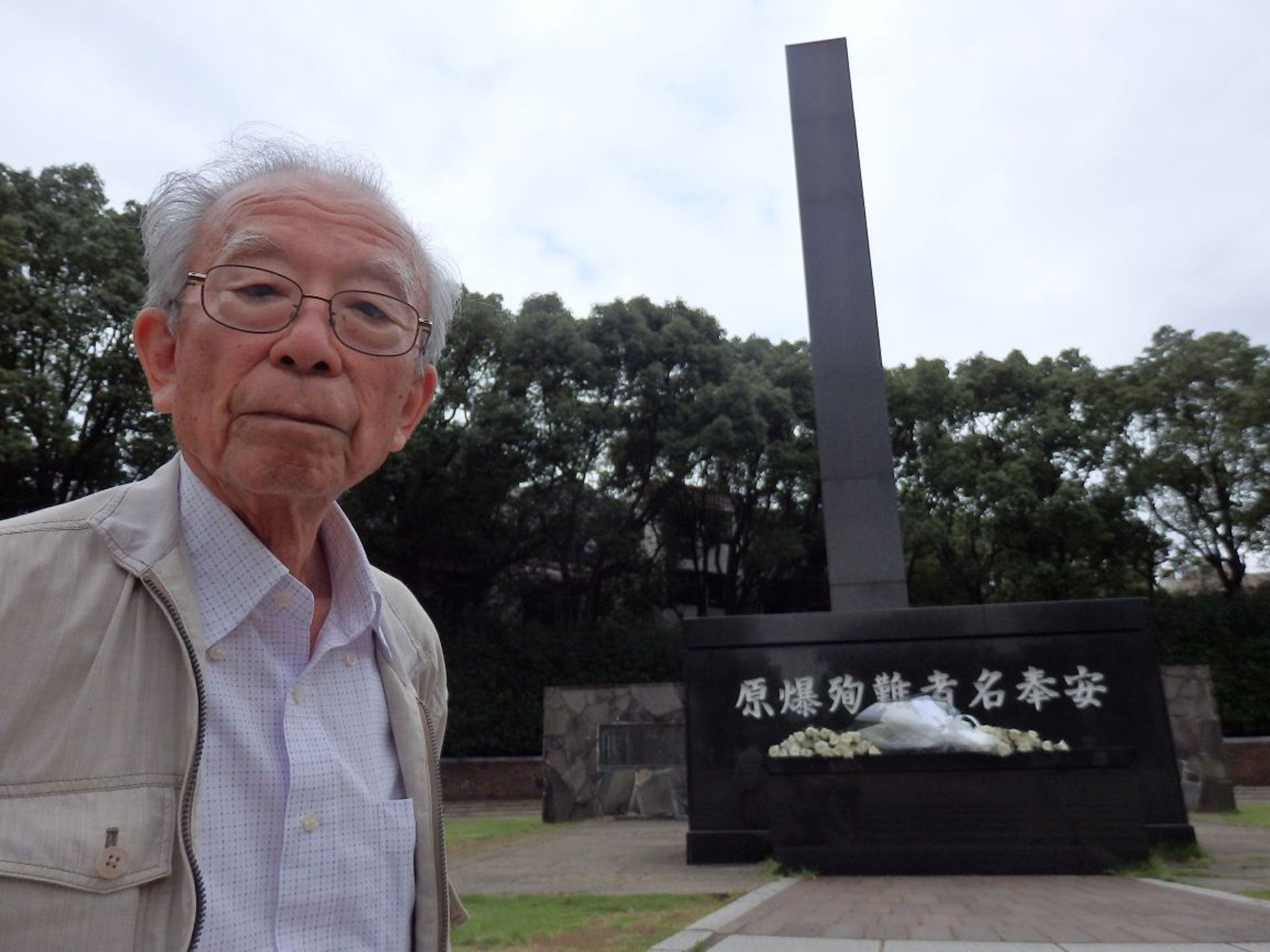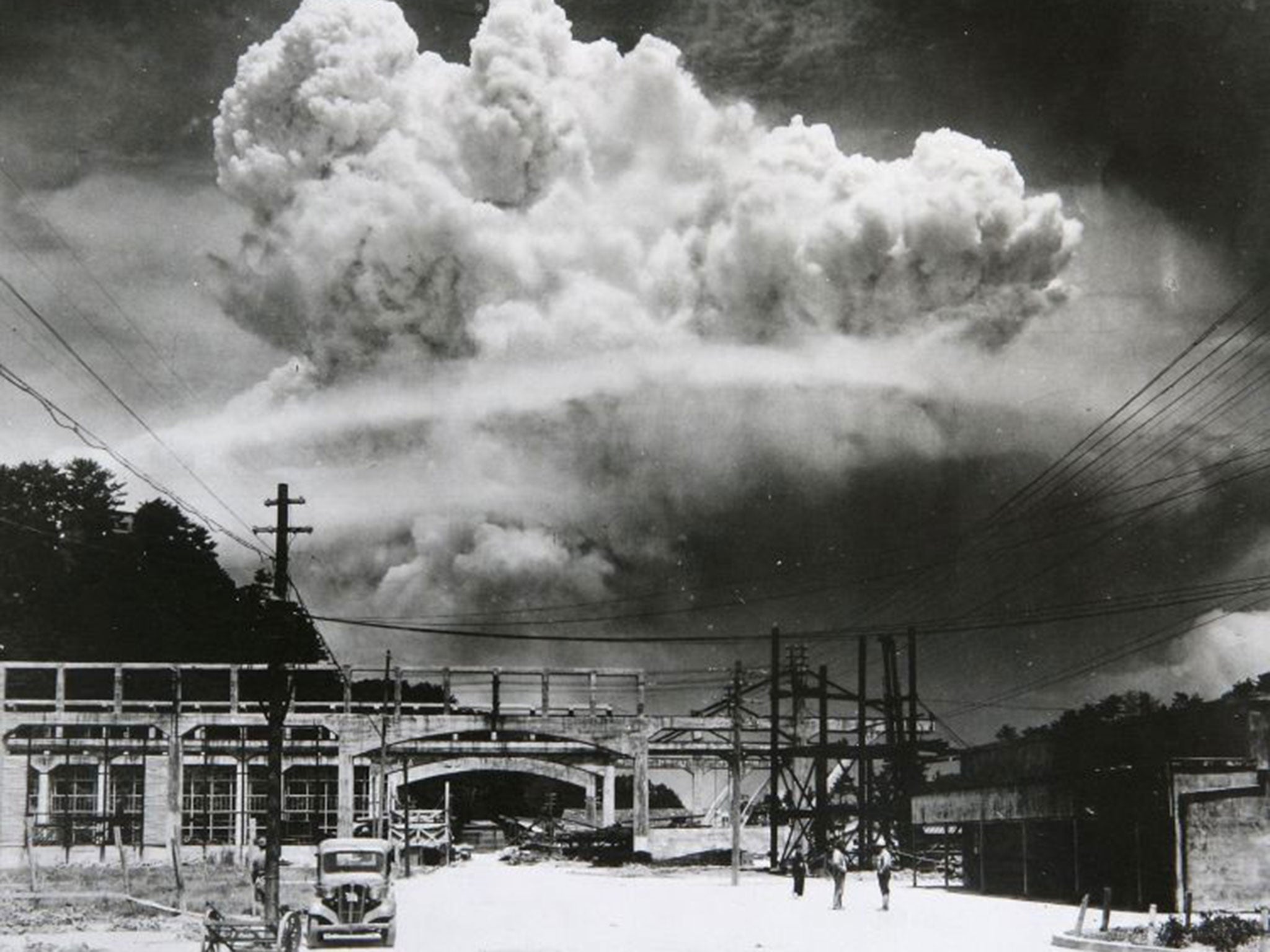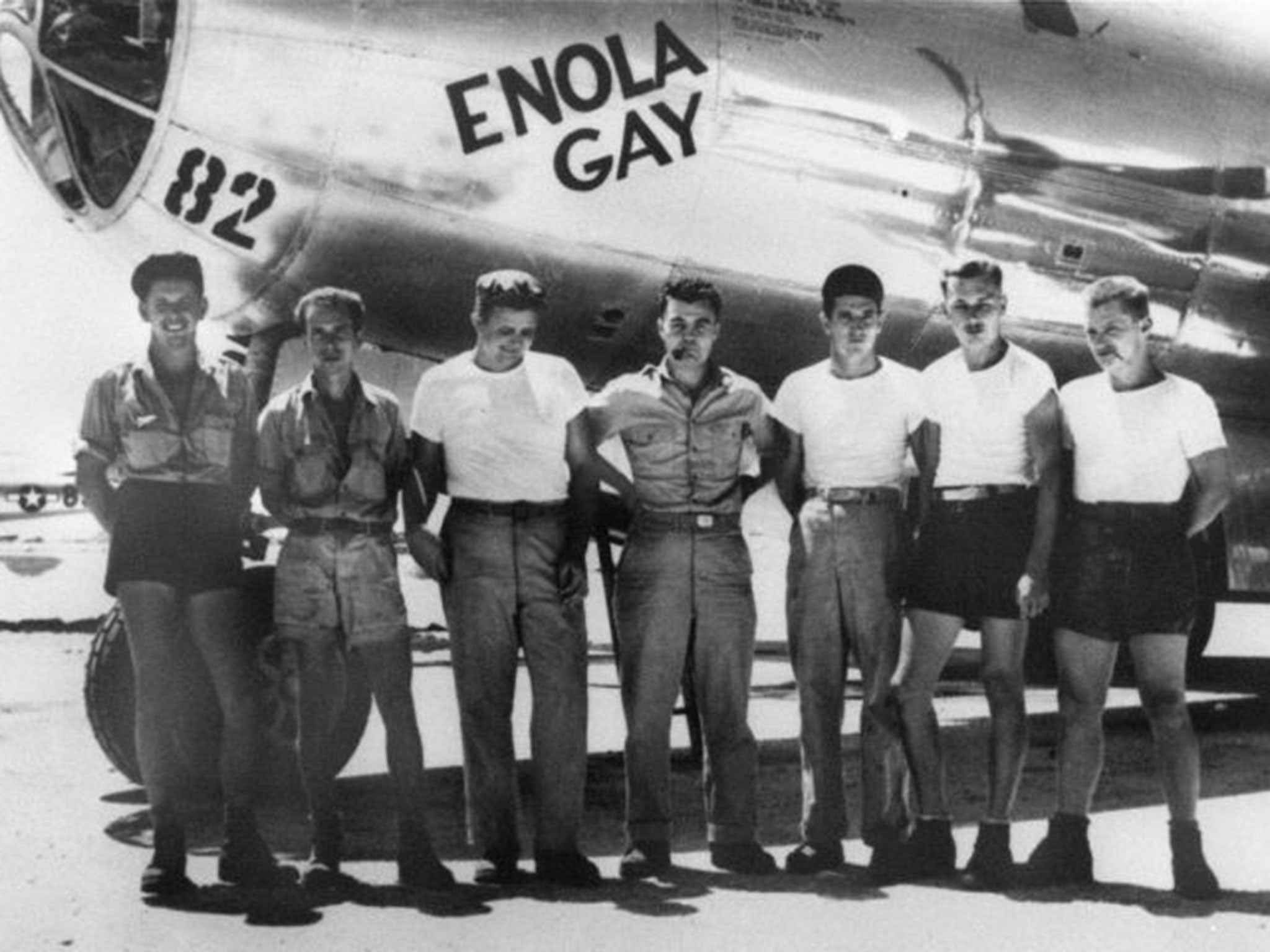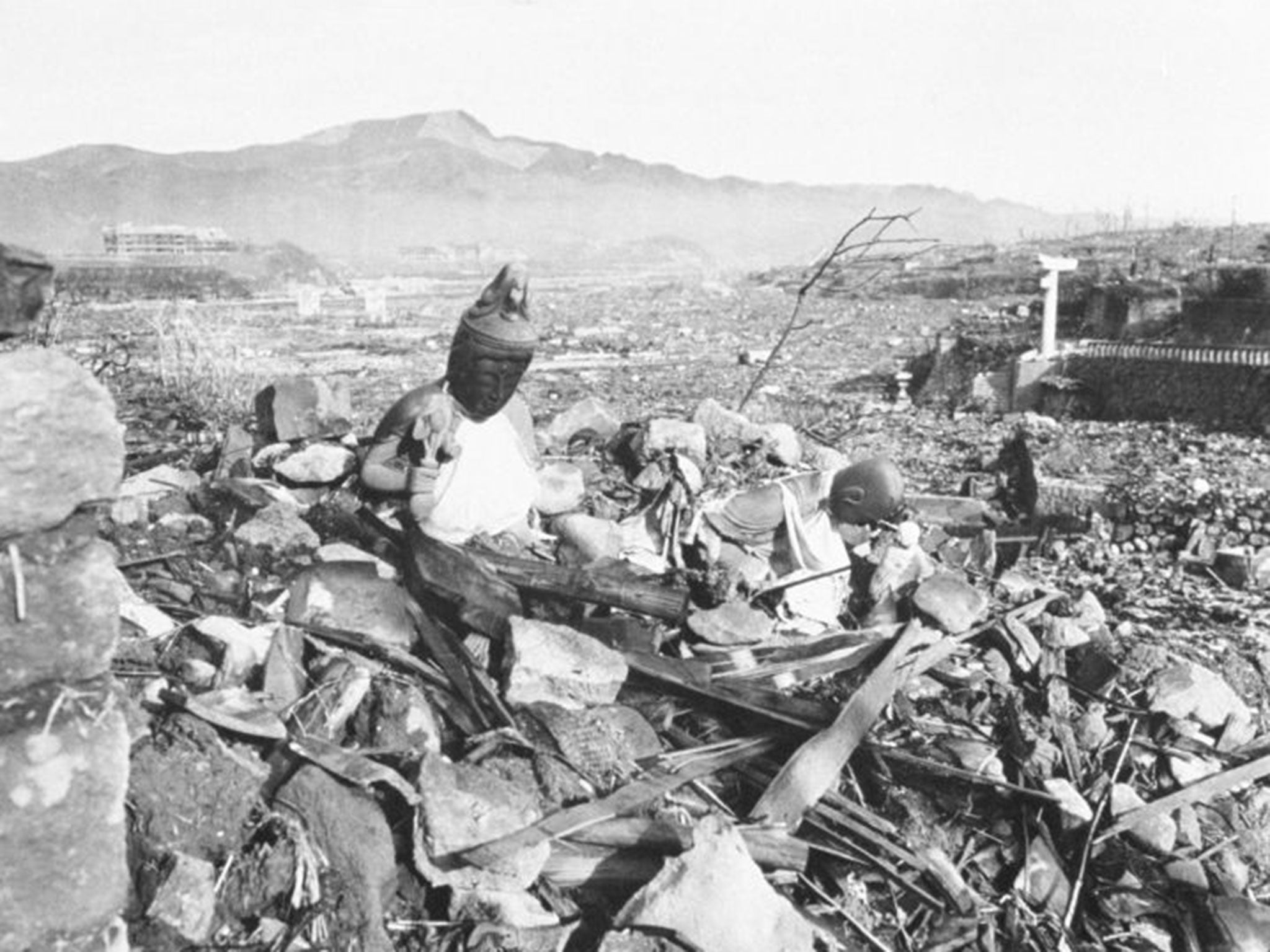Survivors of the Nagasaki atomic bomb attack: Japan must not abandon its post-war pacifism
In the first of a series marking 70 years since the atomic bombs fell, Nagasaki’s survivors describe that day in 1945, and lament Japan's militaristic posturing

Luck and geography decided life or death in Nagasaki. Hirotami Yamada survived because he was at school, a little over a mile from the hypocentre of the plutonium bomb which was dropped on the city almost 70 years ago.
At 11.02am on On 9 August, 1945, the flash and heat from the detonation felt like the sun had fallen from the sky; then everything went dark, Mr Yamada recalls. When the light returned, much of Nagasaki was vaporised in a cloud of smoke and dust that barrelled a mile up into the clouds.
Mr Yamada recalls walking through the seared, flattened landscape to find his family, 900 metres from where the bomb exploded. Charred, blind survivors begged the able-bodied for water.

“I saw people so injured along the way that you couldn’t tell if they were alive or dead,” he says. “But my family looked unhurt, just scratches. We were so relieved.” By the end of the summer, they would nearly all be dead.
First to go was his nine-month-old brother, Takashi, who cried incessantly before finally falling quiet. His mother shook him then fell asleep holding the dead baby in her arms. When morning came, his 16-year-old sister, Misao, had stopped breathing too, he says. Before the bodies could rot in the baking heat, Mr Yamada, then 14, scoured the neighbourhood for wood and built a makeshift pyre.
As the corpses burned, his mother was silent, staring at the ground. Now 84, Mr Yamada still regrets not protecting her from the sight. “I didn’t know, as a child, how she must have felt.” He packed the ashes and bones into an empty can of baby-milk powder. Takashi’s remains fit easily, he says, but the bones of his sister were too big. He wrapped the makeshift urn in a piece of cloth, and buried it in a patch of scorched ground.

Nagasaki was a victim of bad weather, and fate. The primary target, the city of Kokura, was obscured by cloud and haze. The US President, Harry Truman, had called the destruction of Hiroshima three days earlier, along with about 140,000 human beings, “the greatest thing in history” and predicted that it would end the Second World War. When Japan showed no sign of surrender, a pilot, Major Charles Sweeney, was sent back with a second bomb.
The “Fat Man”, a 10,300lb (4,670kg) atomic bomb dropped from a Boeing B-29 Superfortress heavy bomber nicknamed Bockscar, took 70,000 lives in 1945 and destroyed Urakami Cathedral, Asia’s largest Catholic cathedral, in the heart of Japan’s oldest Christian community.
Major Sweeney, an Irish-American catholic who had also flown in Enola Gay, the US aircraft which bombed Hiroshima, never publicly expressed regret. “There’s no question in my mind that President Truman made the right decision,” he later said.
Japan’s military campaign in Asia, studded with atrocities that included the bombing and mass murder of civilian populations in China, helped fuel America’s entry into the war in 1941.
Yet, a few years later, the US and British air forces became the “apostles of strategic bombing” and perfected the techniques of urban destruction, fuelled by an annihilationist policy against Japan that culminated in the incineration of most its cities and the death of over 400,000 civilians. A poll in late 1945 found over 22 per cent of Americans wished more atomic bombs had been dropped on Japan.

But what was left to destroy? Yoshitoshi Fukahori, who was 16 when Nagasaki was bombed, remembers so little left standing he had to use the ruins of Urakami Cathedral to navigate – and his terror as victims emerged from the ruined city, begging for water. “They were clinging to my legs,” he says. “I filled an old cider bottle with water and gave each one a sip, but it was a mistake. More came, their mouths open, and I grew afraid. So I ran away.”
Today, Mr Fukahori is one of 200,000 elderly survivors from both atomic bombings recognised by Japan’s government. They are monitored and carry a card that gives them lifelong health benefits. The hibakusha, as they are known, are a political lobby, lending the moral weight of their suffering to the global anti-nuclear cause. But they are often reluctant campaigners. “Most of us don’t want to talk about what happened,” says Mr Yamada.
Many are angry with the government of Prime Minister Shinzo Abe, who wants Japan to become a more active military partner with America, its old enemy. Mr Abe’s “proactive pacifism” will make Japan America’s proxy army, say the hibakusha, pulling the nation away from the anti-war ideals that survivors of Hiroshima and Nagasaki have symbolised since 1945.
Tomihisa Taue, the mayor of Nagasaki, told The Independent that he understands these concerns but is reluctant to be drawn into criticism of the central government. “I think Mr Abe needs to explain carefully why these changes are needed,” he says. Whatever happens, he adds, his city must keep explaining the inhumanity of nuclear weapons. “We have a mission to communicate that to the world.”
The legacy of Nagasaki is still fought over. The US government plans to turn Los Alamos National Laboratory, the facility in New Mexico used to develop and test the first A-bomb, into a national historical park. Mr Taue says the park must record the suffering caused by nuclear weapons and not simply celebrate their creation. “We are concerned that America will record what happened below the mushroom cloud, and not just above it.”
Mr Yamada is recovering from lung cancer, the same disease that killed his father in 1961. Nobody can prove the cancer came from the bomb, he says – his father was a heavy smoker. But he has lost many friends to the disease. At first they thought the Americans had dropped poison gas before learning about radiation, the deadly toxin left behind by the Fat Man. “Nobody told us anything,” he says.
His mother passed away in hospital toward the end of that summer of 1945, listless and exhausted, unable to say goodbye. A few days later, his brother Akira, who was 12, also died, his body weakened by vomiting and bloody diahorrea. His father was badly ill but recovered as the scorching summer waned. The two surviving members of the family never talked about what happened, he says. They just got on with life.
As Mr Yamada walks around Nagasaki’s Peace Memorial Park, he briefly stops below a statue at the entrance: a mother holding a dead baby with a plaque beneath showing the date and time of the bombing. Mr Yamada grimaces. “I hate this statue,” he says. “It’s too pretty. The reality was much uglier, too ugly to describe.”
Nuclear weapons: Do we need them?
Most Americans still consider the decision to use atomic weapons in the Second World War to be the correct one, polls suggest. But support among women and the young is declining.
Successive US presidents have defended the bombings, saying they helped to end the war and save lives on both sides. In 1991, President George HW Bush declared that the nuclear attacks had “spared millions” of Americans.
America has conducted more than half of the world’s 2,000 nuclear tests since 1945. It maintains about 4,760 of the world’s 15,700 nuclear warheads, a total that included about 10 developed by the world’s newest nuclear power, North Korea, according to the “Bulletin of the Atomic Scientists”.
Under President Barack Obama, the US has reported cutting a total of 158 strategic warheads and plans further cuts by 2018. But it also plans to spend up to $350bn on “modernising and maintaining its nuclear forces”, says the bulletin.
Despite being the only country to be devastated by atomic bombs, Japan shelters under the US nuclear umbrella. Japanese politicians hint occasionally at a further step: in 2011, Shintaro Ishihara, then governor of Tokyo, said Japan should have its own arsenal.
“People talk about the cost and other things, but the fact is that diplomatic bargaining power means nuclear weapons,” he added. “All the members of the UN Security Council have them.”
Join our commenting forum
Join thought-provoking conversations, follow other Independent readers and see their replies
Comments